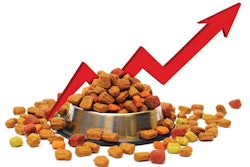
In the United States, pet food sales value grew to US$77.5 billion in 2022 compared to 2021, despite relatively slow volume growth. To reach that figure, U.S. pet food sales grew at 13.4% last year, but the rate differed by channel. E-commerce pet food sales made up 38% of sales while growing 18.8% compared to 2021. Brick-and-mortar retail sales still made up the majority of the pet food market at 62%, but grew at 10.2%.
“Nearly all categories are growing online faster than they are in store,” Andrea Binder, client director of the retail pet channel for NielsenIQ, said during her presentation at Global Pet Expo on March 22 in Orlando, Florida, USA.
I want my free, daily news update from Petfood Industry.
Although pet food and treat sales have grown in value online and in stores, sales didn’t grow as much by volume in 2022.
“Units sold a little bit different story,” she said “We started to see units decline roughly five, six or 10% across the channels in q4. So, really all of that dollar growth is being driven by inflationary pressure.”
Changes to pet food spending patterns in 2022
As inflation made pet foods and treats more expensive, pet owners altered their purchasing habits.
“We've been getting lots of questions around how the consumer is trading across the categories with that inflationary pressure,” Binder said. “Let's start with dry dog food. We see a bit of a decline in premium dry dog food and really a growth in private label. Customers are still looking potentially for those attributes, such as healthy ingredients that you would get with a premium dog dry dog food, but maybe a more value option like a private label offering in that space. Wet dog food tells a slightly different story. We still see declines in premium and a growth in private label, but it might be more of a continuum there. We see a decline in premium, but then a growth in the middle tier, and then a decline in value-priced and growth in private label. The consumer may be trading down a bit more within the wet dog food space. Dry cat food has a little bit different story as well. There's not a whole lot of movement within this space, a little bit up in private label and a little bit down in value. It may be there’s a little bit of a trade from a value to a private label option. But not a lot of movement out of the premium space.”
Some of these changes may be attributable to supply chain issues along with inflation, she said.


















